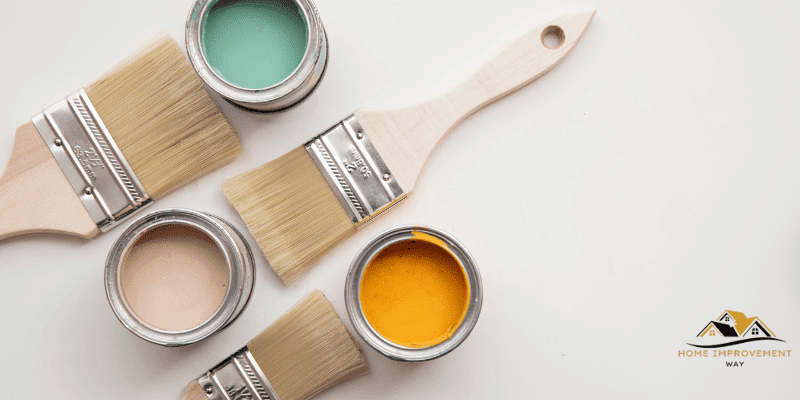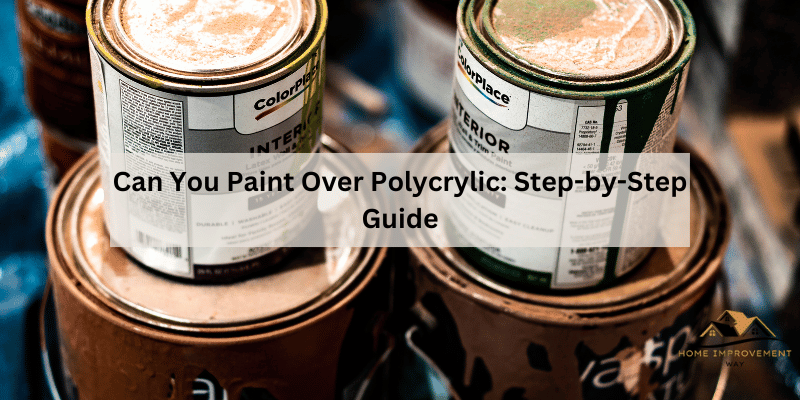Yes, you can. Painting over polycrylic is possible with proper preparation.
Polycrylic creates a smooth and hard surface that can be painted over with the right technique. When looking to paint over polycrylic, it’s important to follow specific steps to ensure the paint adheres properly and creates a lasting finish. With the right preparation, you can successfully paint over polycrylic to achieve the desired look for your project.
This article will provide insights into the process of painting over polycrylic, including the necessary steps and considerations to achieve a professional result. Whether you’re working on furniture, trim, or other surfaces treated with polycrylic, mastering the art of painting over this material will be beneficial for your DIY endeavors.
Understanding Polycrylic And Its Properties
Polycrylic is a durable protective finish commonly used on wood surfaces. You can paint over it by following these steps: sand the surface, apply primer, and then repaint. It’s important to properly prepare the surface for the new paint to adhere.
Understanding the properties of Polycrylic is crucial for a successful paint job.
Compatibility With Paint: Can You Paint Over Polycrylic?

Preparing The Surface For Painting
Before painting over polycrylic, it’s crucial to properly prepare the surface to ensure good adhesion and a smooth finish. This involves cleaning the polycrylic surface, using the right sanding techniques, and choosing the appropriate primer. Here’s a closer look at each step:
Cleaning The Polycrylic Surface
Cleaning the polycrylic surface is the first essential step in preparing for painting. Use a mild detergent solution and water to thoroughly clean the surface. After cleaning, rinse with clean water and allow it to dry completely before proceeding with sanding and priming.
Sanding Techniques For Proper Adhesion
Proper sanding techniques are crucial for ensuring excellent adhesion of the paint. Use fine-grit sandpaper (such as 220-grit) to lightly sand the polycrylic surface. This will create a slightly roughened texture, allowing the paint to adhere effectively. After sanding, be sure to remove any dust or debris from the surface before applying the primer.
Choosing The Right Primer For Polycrylic
Choosing the right primer is essential for achieving a successful paint job over polycrylic. Opt for a high-quality bonding primer specifically designed for use on slick surfaces like polycrylic. Ensure the primer is compatible with the type of paint you plan to use, whether latex or oil-based. Apply the primer evenly and allow it to dry thoroughly according to the manufacturer’s instructions before applying the paint.
Choosing The Right Paint For Polycrylic Surfaces
Choosing the right paint for polycrylic surfaces is crucial to achieving a professional, long-lasting finish. Whether you’re working on a woodworking project or refreshing the look of furniture, finding the perfect paint that adheres well to polycrylic can make all the difference in the final result.
Selecting Paint Types For Polycrylic Finish
When selecting paint types for a polycrylic finish, it’s important to consider the specific characteristics of the surface. Polycrylic is a water-based protective coating that dries to a hard, clear finish. Therefore, it’s essential to choose a paint that is compatible with water-based finishes and provides excellent adhesion to create a durable bond.
Best Paint Brands For Polycrylic Surfaces
Several renowned paint brands offer products specifically designed to work well with polycrylic finishes. Look for high-quality paints from trusted brands such as Behr, Sherwin-Williams, and Benjamin Moore, as they are known for producing paints that adhere exceptionally well to polycrylic-coated surfaces.
Factors To Consider When Choosing Paint For Polycrylic
When selecting paint for polycrylic surfaces, several factors should be taken into account to ensure the best outcome. Consider the sheen of the paint, as higher sheen paints tend to adhere better to the slick surface of polycrylic. Additionally, the paint’s compatibility with water-based finishes, its adhesion properties, and the intended application area should all be carefully evaluated before making a selection.
Step-by-step Guide To Painting Over Polycrylic
If you’ve ever wondered if you can paint over polycrylic, the answer is yes! With the right tools and techniques, you can achieve a smooth and flawless finish on your painted surface. In this step-by-step guide, we’ll walk you through the process of painting over polycrylic, from preparing the surface to applying the final coat of paint.
Application Tools And Techniques
Before you start painting over polycrylic, it’s essential to gather the necessary application tools and understand the proper techniques for the best results. Here are some tools and techniques you’ll need:
- Preparation: Begin by cleaning the surface with a mild detergent to remove any dirt or grease. Then, lightly sand the polycrylic finish to create a rough surface for the paint to adhere to.
- Primer: Applying a primer specifically designed for slick surfaces can help the paint bond effectively with the polycrylic.
- Paint Application: Use a high-quality paintbrush or roller to apply the paint in thin, even coats. Avoid overworking the paint, as this can lead to streaks and uneven coverage.
Applying The First Coat Of Paint
Once you’ve prepared the surface and gathered the necessary tools, it’s time to apply the first coat of paint over the polycrylic. Here’s how to do it:
- Priming: Apply the primer evenly over the sanded polycrylic surface, allowing it to dry completely before moving on to the next step.
- First Coat: Use a high-quality paintbrush or roller to apply the first coat of paint in smooth, controlled strokes. Ensure even coverage and avoid overloading the surface with paint to prevent drips and runs.
- Drying Time: Allow the first coat of paint to dry completely according to the manufacturer’s instructions before applying additional coats.
Drying And Sanding Between Coats
For a flawless finish, it’s crucial to allow each coat of paint to dry thoroughly and sand between coats for a smooth and even surface. Follow these steps for drying and sanding between coats:
- Drying: After applying each coat of paint, allow it to dry completely before proceeding to the next coat. This ensures proper adhesion and prevents smudging or blending of colors.
- Sanding: Gently sand the dried paint with fine-grit sandpaper to level out any imperfections or rough areas. Wipe away any dust before applying the next coat of paint.
Finishing Touches And Maintenance
When it comes to adding a protective and durable finish to your painted surfaces, polycrylic is an excellent choice. After successfully painting over polycrylic, it’s important to focus on the finishing touches and maintenance to ensure the longevity of the painted surface.
Final Coating Over The Paint
Once the paint has been applied over the polycrylic, it is advisable to apply a final coating to provide additional protection and enhance the overall durability of the surface. Choose a compatible clear coat or varnish that is suitable for the type of paint used. Make sure to follow the manufacturer’s recommendations for application and drying times to achieve the best results.
Maintenance Tips For Painted Polycrylic Surfaces
Keeping your painted polycrylic surfaces in top condition requires proper maintenance. Here are some essential maintenance tips to preserve the integrity of the finish:
- Regular Cleaning: Use a mild soap and water solution to gently clean the surface, avoiding abrasive cleaners that could damage the paint and polycrylic finish.
- Avoid Rough Handling: Prevent scratching or gouging of the surface by using coasters, placemats, or felt pads under objects to protect the painted area.
- Proper Storage: When storing items on the painted surface, use caution to prevent any sharp edges or heavy objects from causing damage.
- Temperature Control: Maintain a consistent room temperature to prevent extreme fluctuations that may affect the painted surface.
- Touch-up when Necessary: Inspect the surface periodically and touch up any areas where the paint or polycrylic may have been damaged or worn over time.
Frequently Asked Questions For Can You Paint Over Polycrylic
Can I Paint Over Polycrylic Without Sanding?
Yes, you can paint over polycrylic without sanding, but it’s crucial to clean the surface thoroughly and use a suitable primer for better adhesion of the new paint.
What Type Of Paint Can I Use Over Polycrylic?
You can use water-based or oil-based paint over polycrylic. However, make sure to choose a high-quality paint that adheres well to surfaces and provides a durable finish.
Is It Necessary To Apply A Primer Before Painting Over Polycrylic?
Yes, applying a primer before painting over polycrylic is essential for better adhesion and a long-lasting finish. Choose a primer designed for use over sealed or glossy surfaces for optimal results.
Conclusion
Painting over polycrylic is doable with proper prep work. By following the necessary steps and using the right materials, you can achieve a smooth, durable finish that enhances your surfaces. Remember to sand and prime before painting, and always test in an inconspicuous area.
With patience and attention to detail, you can transform your polycrylic-covered surfaces with confidence.


